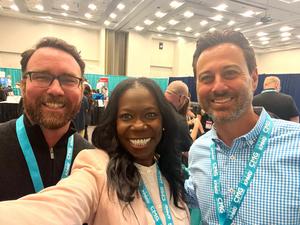When Niki Watson decided to return to school for her master’s degree, she wanted something that could fit nicely with her bachelor’s in biology.
Watson was considering a master’s in curriculum and instruction when an adviser at University of Tampa suggested she try a new degree program in instructional design and technology, offered through the university’s graduate education program.
“I was already teaching biology in my first job out of college,” Watson said. “I wanted something that was education-related, but a little bit more technical. So instructional design was actually a perfect fit for me.”
The program took two years to complete. Watson’s life was a bit of a balancing act during that time. “I was teaching at the same time, and I had just had my second child. Even though it was a pretty tough experience, it was valuable.”
A few months before she finished the program, Watson was offered a job as an instructional designer at Pasco–Hernando State College. After two years, she was promoted to senior instructional design coordinator.
“I was making more than your typical classroom teacher but still working in education, and that was something that I always had wanted,” Watson said. She has since taken a job as learning and development manager in the education department with ConnectWise, a Tampa-based company that creates software for technology teams.
Growing field
Demand from businesses looking for course designers was one of the reasons University of Tampa began offering the master’s degree in instructional design and technology in 2014, said Enilda Romero-Hall, graduate coordinator and assistant professor. The track marries education, human resources and technology to position students for wide-ranging careers in business, K-12 schools, higher education, government and military.
“The program prepares students to navigate the intricacies of designing learning experiences and developing human performance solutions,” Romero-Hall said. Core coursework includes learning theory, systematic instructional design and trends and issues in the field, which is one of the fastest-growing jobs in education.
Companies are creating positions for in-house instructional designers to train their own employees and also to educate clients and customers about their products, Romero-Hall said. “The field is evolving and changing constantly,” Romero-Hall said, especially with the rise of online and distance learning, a segment where there are ample career opportunities for course developers.
Software skills covered in UT’s program include Articulate Storyline, Camtasia and Adobe Captivate. The degree concludes with the creation of a professional portfolio.
Aside from e-learning, degree specializations include curriculum design, human performance technology, information systems management and performance evaluations, Romero-Hall said. That gives students plenty of flexibility.
“You can come from very diverse backgrounds into the program and use the knowledge you already have from prior experience to craft a career,” Romero-Hall said. “We have students whose undergraduate majors were health care, psychology, graphic design, communications, business, management, biology, music and more.”
Students are hired quickly upon graduation, Romero-Hall said, and have landed jobs with organizations including Citibank, Hillsborough Community College and University of Tampa itself. They have quickly find jobs in other parts of the country as well, Romero-Hall said.
New opportunities
University of Tampa’s instructional design and technology program is growing. Ten will graduate this fall, and about 50 students are enrolled in the program.
Anthony Gill is one of them. He studied education and taught in various charter schools for a few years before being laid off when the school’s test results did not meet state standards. At that point, he decided he wanted to go in a different direction and landed on instructional design and technology. He began the UT program this year.
Designing courses comes naturally to Gill, who has used the skill in ministry for some time. He enjoys delighting children with a puppet show he wrote and performs.
“I've always had that ability to work in technology with software,” Gill said. “And, of course, my work in education designing lessons. I wanted to find a path that was going to marry the things I do really well – teach and design. And then, and of course, working with kids is something I truly enjoy.”
Learn more about a M.S. in instructional design and technology at the University of Tampa.
Katy Smith is a freelance writer for The Business Journals.





